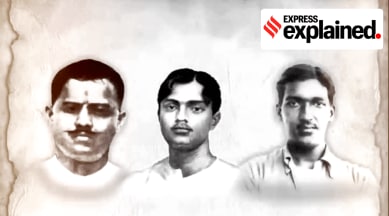KAKORI INCIDENT
1.Context
Four revolutionaries of the Indian independence movement were hanged on December 17 (Rajendranath Lahiri) and December 19 (Ashfaqullah Khan, Ram Prasad Bismil, Thakur Roshan Singh) in 1927.
2. Kakori Train Robbery
The hanging of revolutionaries came two years after the Kakori Train Robbery, in which members of the Hindustan Republican Association (HRA) had looted a train transporting money to the British treasury. After the event, the British authorities launched an intense manhunt, leading to the eventual arrest of several members of the HRA.
3. Events Which Led To The Formation Of the Hindustan Republican Association
In 1920, Mahatma Gandhi declared the launch of the Non-Cooperation Movement, a campaign that asked Indians to revoke their support from any activity that "sustained the British government and economy in India.”
However, an incident changed the movement’s trajectory in 1922. After police firing killed three protesting men in the town of Chauri Chaura in present-day Uttar Pradesh, a mob later set fire to the police station, burning 22 policemen to death.
In his autobiography, Pandit Jawaharlal Nehru said this incident led to the “sudden” end of the Non-cooperation movement, with Gandhi calling it off despite significant internal disagreement within the Indian National Congress (INC).
4. Founding Of The Hindustan Republican Association
The HRA was thus founded by a group of young men who were disillusioned by Gandhi’s tactics and what they felt was zealous preaching of “non-violence.”
Ram Prasad Bismil and Ashfaqulla Khan, both of whom had a flair for poetry, were among the group’s founders. Others included Sachindra Nath Bakshi and trade unionist Jogesh Chandra Chatterjee. Figures such as Chandra Shekhar Azad and Bhagat Singh would also join the HRA.

5. Manifesto Of HRA
- Their manifesto released on January 1, 1925, was titled Krantikari (Revolutionary).
- It proclaimed, “The immediate object of the revolutionary party in the domain of politics is to establish a federal Republic of United States of India by an organized and armed revolution.” The manifesto looked at these revolutionaries as “neither terrorists nor anarchists… they do not want terrorism for terrorism’s sake although they may at times resort to this method as a very effective means of retaliation.”
- Their envisioned republic would be based on universal suffrage and socialist principles, importantly, the “abolition of all systems which make the exploitation of man by man possible.
6. Kakori Train Action incident
- The train robbery at Kakori was the HRA’s first major action, in August 1925.
- On August 9, 1925, as the train was passing the Kakori station, about 15 km from Lucknow, Rajendranath Lahiri, a member of the HRA who was already seated inside, pulled the chain and stopped the train.
- Subsequently, around ten revolutionaries, including Ram Prasad Bismil and Ashfaqullah Khan, entered the train and overpowered the guard.
- They looted the treasury bags (containing approx Rs 4,600) and escaped to Lucknow.
- Due to a misfiring Mauser gun, one passenger (a lawyer named Ahmad Ali) was killed during the robbery, harming the revolutionaries’ intentions to elicit a positive public reaction.
- The British authorities were enraged, undertaking a violent crackdown and soon arresting many members of the HRA.
- Bismil was arrested in October 1925, supposedly after two members of the HRA betrayed him. Ashfaqullah escaped to Nepal and then Daltonganj (in present-day Jharkhand).
- He would be arrested a year later, Out of the forty men arrested by the British, four were handed death sentences, while others received lengthy prison terms.
- The only major leader of HRA at this time who evaded arrest was Chandrasekhar Azad.
7. HRA Afterwards of Kakori Episode
- In 1928, a year after the execution of the Kakori Conspiracy accused, the HRA merged with various other revolutionary groups that had emerged in Punjab, Bihar, and Bengal and became the Hindustan Socialist Republican Association (HSRA).
- Gradually it made its Marxist leanings more explicit, working with the Communist International and speaking of a revolution involving a struggle by the masses to establish “the dictatorship of the proletariat.”
- By the 1930s, the HSRA had lost steam with many of its prominent leaders either dead or in prison. However, over the latter half of the 1920s, the group was key in carrying out various acts of resistance against British rule, participating in protests against the Simon Commission.
8. Why did the Kakori incident elicit such strong reactions?
- The severity of the British response was somewhat surprising, especially the handing out of capital sentences.
- One way to view the Kakori incident is to see the symbolic message that it sent to the British Raj.
- While the sum stolen was paltry, such an act was unprecedented in the Raj where specifically money meant for the British treasury was looted.
- The British response to Kakori was to set an example for future revolutionaries and restore British authority in the minds of the people.
|
For Prelims :Illbert bill, Kakori, Hindustan Republican Association
For Mains:
1. India got Swaraj in 1947. It must now strive for Swaraj or good governance. Discuss.
|
Source: The Indian Express




